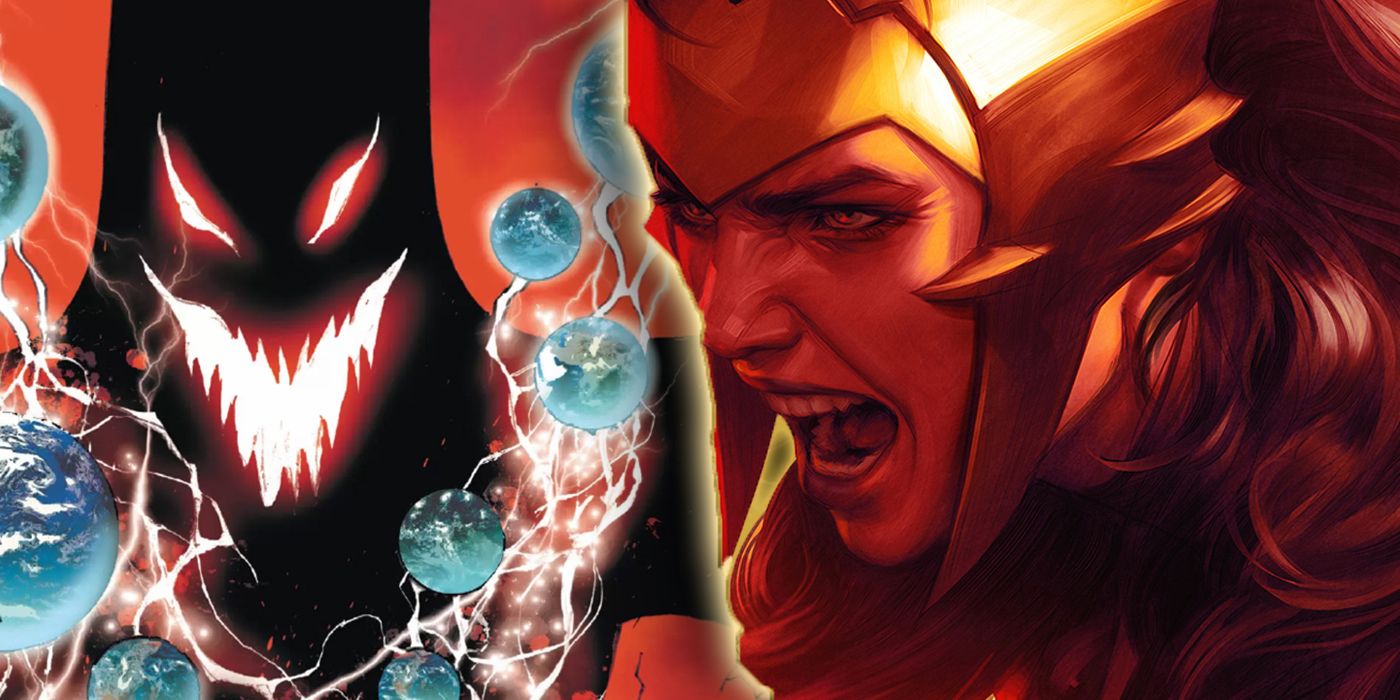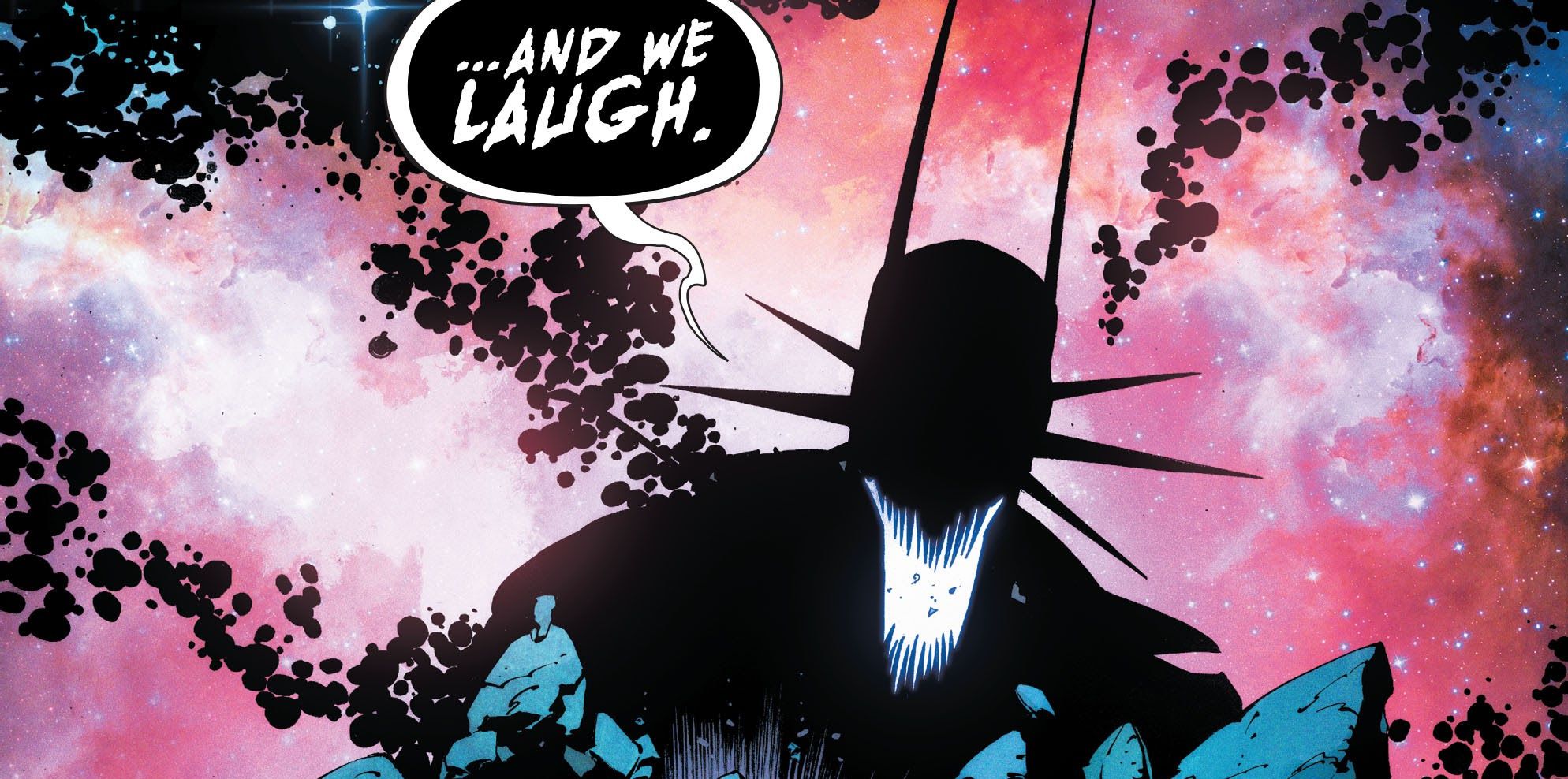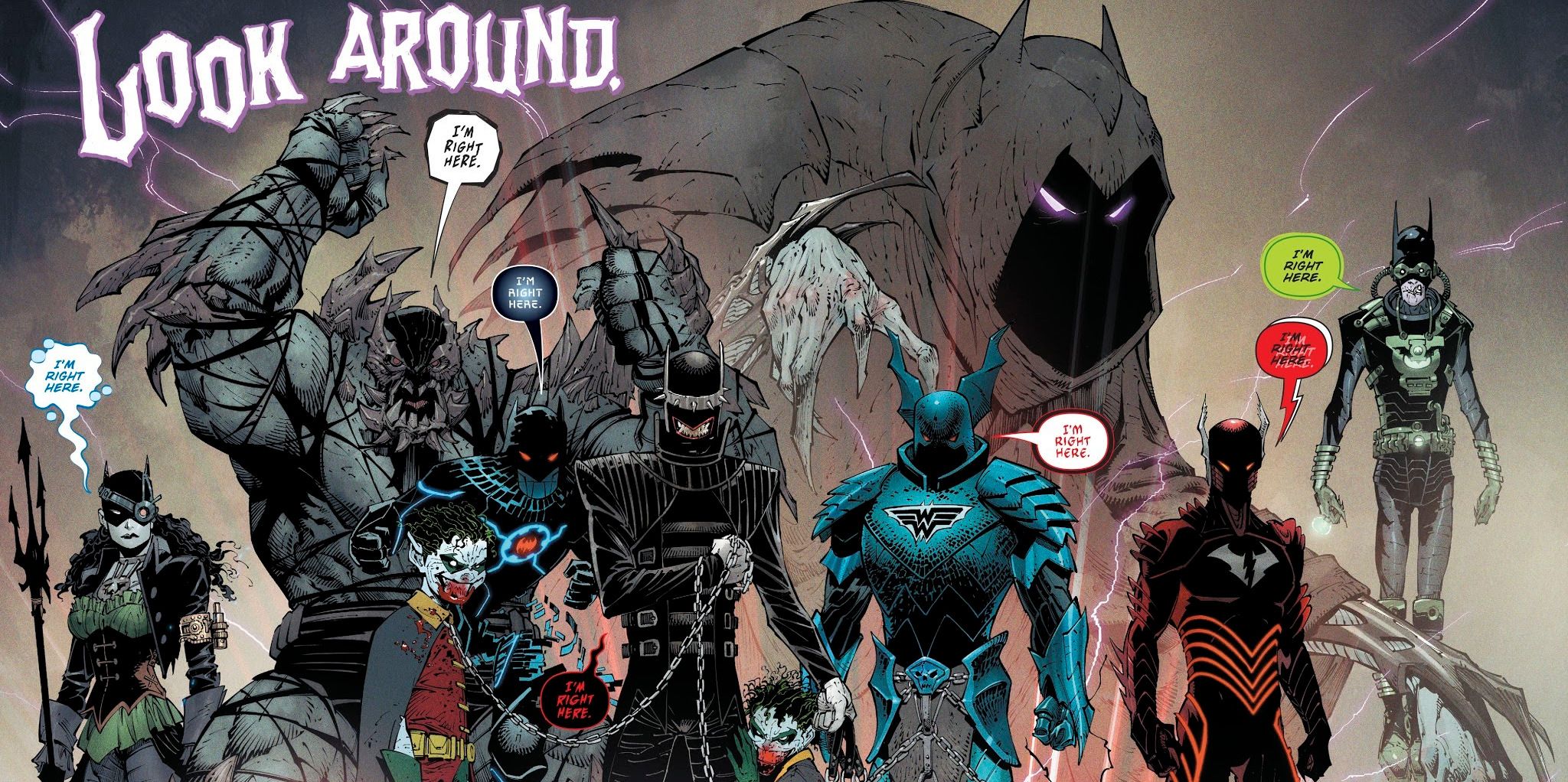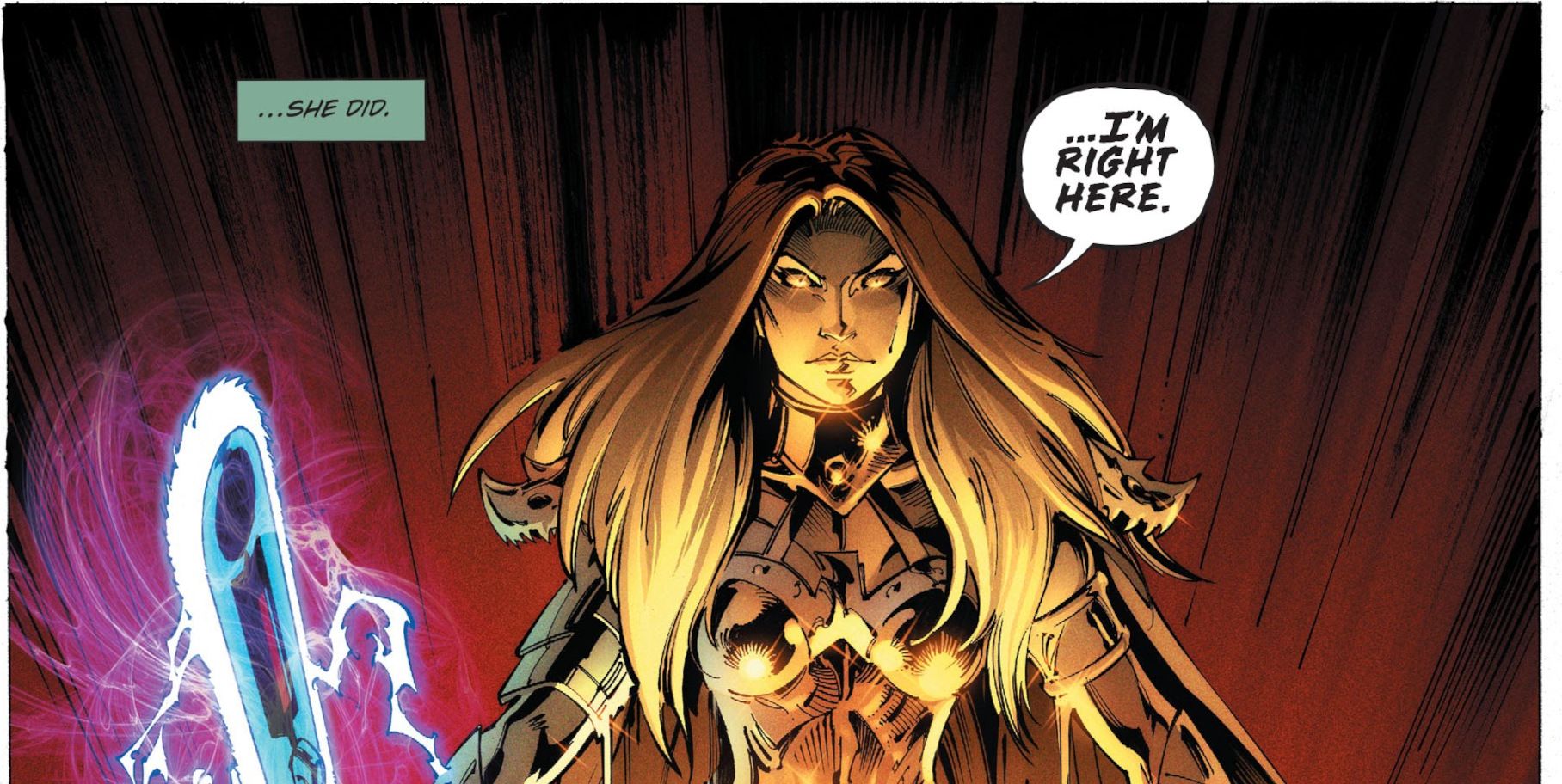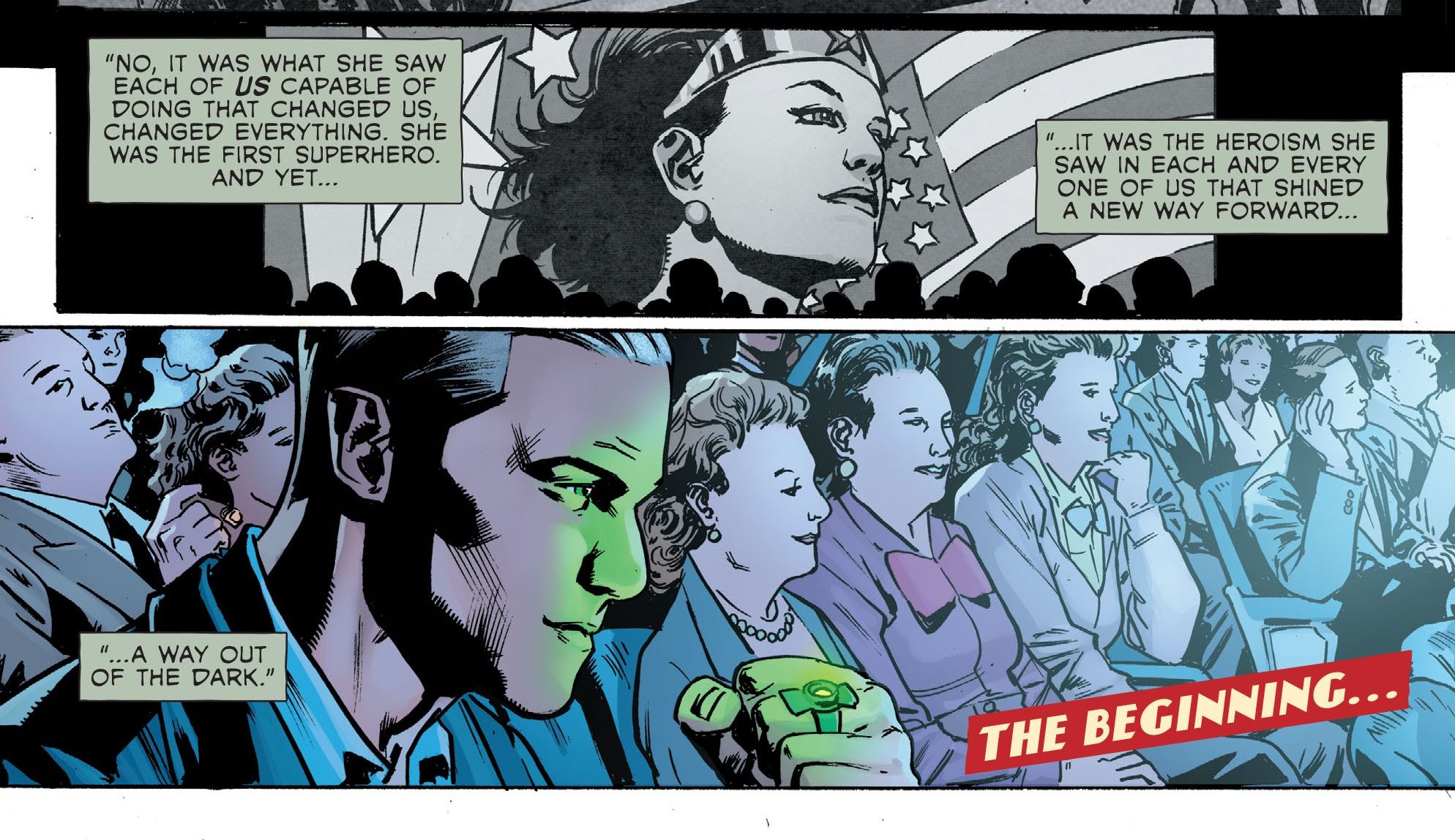WARNING: The following contains spoilers for Dark Nights: Death Metal #6, by Scott Snyder, Greg Capullo, Jonathan Glapion, FCO Plascencia & Tom Napolitano, on sale now.
Since Dark Nights: Death Metal and its predecessor lean heavily into musical motifs, Dark Nights: Death Metal #6 is something of a downbeat prelude. In terms of trivia, Easter eggs and minutiae, there's not much new in this issue. Many of the characters have already been introduced, the plot is minimal, and overall it largely sets up Death Metal #7's finale. Therefore, we covered much of the usual trivia, minutiae, etc., in Part 1. However, we've got a lot more to say about the implications of this issue. We have always appreciated the metatextual aspects of Death Metal, and as the miniseries reaches its climax, they're becoming more and more apparent.
Dark Nights: Death Metal #6 was written by Scott Snyder, penciled by Greg Capullo, inked by Jonathan Glapion, colored by FCO Plascencia, and lettered by Tom Napolitano. Jared Blando is credited as cartographer, while Darran Robinson designed the publication. The associate editor was Andrew Marino and the issue was edited by Marie Javins.
Batman Who Laughs' Last Laugh
We've all seen those blockbusters where one massive army simply shuts off when its villainous leader is defeated. Without that singular controlling force, the hordes of cannon fodder practically -- and sometimes literally -- just collapse into heaps. Think of Ultron's killer counterparts in Avengers: Age of Ultron, or the Trade Federation's battle-droid army in The Phantom Menace. To a certain extent, this issue has that too, as the omnipotent Batman Who Laughs is able to command his nightmare army even while he's fighting Perpetua. True to form, then, the Batman Who Laughs' forces retreat near the end of the issue, so that he can bring in more A-listers on Page 17. The Batman Who Laughs trades quantity for quality, but in the end, it probably doesn't matter. As Page 22 indicates, the real fight is just between him and Wonder Woman – and there's more to it than mere ultra-violence.
We're sure we've said it already many times, many ways; but the Batman Who Laughs is perhaps the most cynical character in DC Comics history. To be clear, we're not suggesting that Snyder and Capullo are themselves cynical for creating him, merely that he personifies a remarkably cynical idea. Initially, he was just the unholy combination of Batman and the Joker, a paragon of maximal human potential bereft of any moral compass or benevolent ethical code. Of course, that meant he also represented two of DC's most popular characters, fused into one eminently marketable high-concept.
Conventional wisdom holds that Batman is popular because he takes a handful of spooky creature-of-the-night tropes and flips them around, putting them in service of the helpless and downtrodden. The Batman Who Laughs flips that back, essentially saying "to heck with the helpless and downtrodden" and embracing the Joker's brand of cheerful nihilism. Key to the villain's conception is this notion that Batman's devotion to justice and the law is actually holding him back from fully realizing his aforementioned potential. Thus, the Batman Who Laughs is a kind of final evolutionary stage, augmented in this miniseries with the ultimate power-up. Now the Darkest Night -- who, remember, started out as a very familiar orphan, mourning his murdered parents and dedicating his life to honoring their memories through his crusade -- is able to stand toe-to-toe with Perpetua, the entity who created the DC Multiverse.
We are reminded of September 1966's Justice League of America #47, wherein the Justice League and Justice Society squared off against Anti-Matter Man, a being whose power rivaled the Spectre's. However, the cover of JLA #47 showed a giant Batman socking Anti-Matter Man, because this was the height of the Batman '66 TV show. At that point in Bat-history, the Caped Crusader punching a cosmic bad guy would undoubtedly have sold more comics, regardless of story logic or even issue contents. Over 50 years later, in Death Metal #6, the promise of that cover is fulfilled. We remember an old message-board trope that Batman could beat God if given enough "planning time." Well, he's had ample time to plan, so now this Batman practically is a god.
Failing Upward
Thus, the Batman Who Laughs also takes full advantage of regular Batman's strategic acumen. The original Metal miniseries explained that its evil Batmen all stemmed from some sort of failing in their respective realities. It then revealed that the main Batman had also failed, in the sense that he didn't realize the degree of danger he faced in investigating the Dark Multiverse. Although the Justice League was able to defeat Barbatos and the other Dark Knights, the road to Death Metal was paved additionally with their collective failures – specifically, the Source Wall's destruction and the subsequent mistakes in judgment which enabled both Perpetua and the Batman Who Laughs to take over the Earth.
Now, this dark Batman has capitalized fully on the effects of those mistakes – even, apparently, including being chainsawed in half in Death Metal #1 and has positioned himself at the top of DC's food chain. Once, he was content simply to have honed his mind and body to their sharpest edges, but now he's acquired unimaginable power and divested himself of any responsibility. Now he is – almost literally – the face of the DC Multiverse, which is only appropriate considering how popular Batman and the Joker are. Frankly, it's hard not to see the Batman Who Laughs as DC at its most commercial. (In this respect the Watchmen connection is just a bonus.) The Batman Who Laughs is the personification of what the DC Universe could become if product were all that mattered.
Darkseid makes this plain on Page 12, when he says that the Batman Who Laughs' minions "have no real souls... no hopes, no fears [and] think only of winning." This seems to us to speak directly to the short-term calculations which make various DC properties grimmer, edgier and more "realistic," over the years, Batman may be a sure thing in terms of popularity, but Death Metal drives home the point that Batman-gone-wrong is horrifying.
Apex Amazon
Set to oppose the Batman Who Laughs is Wonder Woman, the youngest of DC's Trinity, at times the most marginalized, and certainly the most idiosyncratic. Superman (introduced in 1938) set the superhero standard and Batman (1939) showed how it can adapt to changing times. In contrast, Wonder Woman (1941) symbolized creator William Moulton Marston's response to what he saw as a troubling set of emerging, male-dominated superhero tropes.
Without going too deep into Marston's particular philosophies, it's sufficient to say that Wonder Woman has also evolved over the decades. In the 1940s, outside of her own series, she was the Justice Society's secretary, recording the team's exploits but rarely participating in them. Throughout the Silver Age, her adventures became increasingly more fanciful, almost to the point of incoherence. (Ironically, considering her history with the JSA, she may have been better-served in Justice League of America than in her own title.) From 1968 to 1973, she was virtually a different character, having given up her powers to lead the life of a secret agent.
In 1986, Wonder Woman was rebooted from the ground up with an updated mission as ambassador to "Patriarch's World," but this also gave her a new perspective. At once innocent to the ways of the modern world and bolstered by her Amazon upbringing, Wonder Woman grew into a unique figure among DC's A-listers. Unlike Batman, she enjoyed parental love and support; and unlike Superman, her home culture was a living reminder of her purpose on Earth. In September 2005's Wonder Woman #219, the "Sacrifice" storyline drove home one more key difference between her and her colleagues: She was willing to snap a supervillain's neck if that was the only way to stop him from murdering anyone else. To be sure, this is about as far from Marston as you could get, but it confirmed the dichotomy at the heart of modern-day Wonder Woman. Although she cherishes love and peace above all else, she is an exceedingly pragmatic warrior.
That act helped justify the friction among the Trinitarians which fed into Infinite Crisis, 52 and the "One Year Later" relaunch. It also earned Max Lord, former Justice League International patron, a prime spot in Wonder Woman's Rogues' Gallery (and, of course, a starring role in Wonder Woman 1984.) However, it solidified a certain "otherness" which further distinguished Wonder Woman from Superman and Batman, and persists in various degrees to this day.
Because she's less well-defined than the World's Finest Team, her handlers have probably felt more free to take more risks with her. Accordingly, even accounting for Sci-Fi Batman and Only-Leaps Superman, Wonder Woman has endured the most changes of all the Trinitarians over her decades of existence. That makes her the ideal vehicle for Death Metal's "everything matters" message, because it means the most to her. We know how the Multiverse (Dark or otherwise) feels about Batman, and Doomsday Clock has told us that the Metaverse basically revolves around Superman. Thus, Wonder Woman – whose creator had some very specific ideas, and whose creative teams have often had to grapple with how to deal with them – is the ideal avatar for the Multiverse that's coming.
Indeed, we know from Scott Snyder and Bryan Hitch's story in Wonder Woman #750 (Late March 2020) that Diana is not only considered DC-Earth's first Golden Age superhero, but the one who helped inspire the Justice Society itself. (This specifically included future Green Lantern Alan Scott, whom Doomsday Clock established as a pivotal figure in DC history.) There's a welcome bit of symbolism in this change, because the ageless Diana of 2020 still contains multitudes that stretch back decades. Of the three Trinitarians, arguably Wonder Woman shows the influences of her creators and subsequent handlers most clearly. A William Moulton Marston/H.G. Peter story is as distinct from a Bob Kanigher/Ross Andru tale as a George Pérez issue is from a Brian Azzarello/Cliff Chiang one. As such, Wonder Woman embodies the sweep of DC's publication history more demonstrably than the gothic-to-goofy-to-grim Batman or the increasingly-powerful Superman.
It all makes us very excited to see how the sum of her adventures expresses itself in Death Metal #7. Wonder Woman versus the Batman Who Laughs is more than a supercharged demigoddess fighting a nigh-omnipotent psychopath. (It's also not an amped-up version of Kingdom Come's final battle, since that was all about how Superman finally intervened.) Instead, it's the embodiment of all that's messy and fascinating about DC versus a high-concept exercise in Bat-exploitation. Wonder Woman was born out of one man's desire to make sure that this new "superhero" idea didn't just devolve into male-dominated power fantasies. She endured despite her creator's early death (in 1947, at age 53), despite wildly divergent efforts from subsequent creative teams, and despite radical changes to her status quo which threatened her creator's legacy and/or the core of her character.
Superman and Batman got lucky: They were hits instantly, and they've survived 80-odd years relatively unscathed. Wonder Woman got lucky too, in that she survived the mid-century comics bloodbath without losing her own series – but her journey hasn't been nearly as easy. Making her the DC Multiverse's single-combat champion is a great way to honor not just her history, but the efforts of all those creative teams on all of DC's other characters. "Everything matters" includes everyone as well. That's why we try to be very diligent about identifying all those disparate comics professionals – because without them, the DC Multiverse would be a very drab place. Gail Simone said it best: "If you need to stop an asteroid, you call Superman. If you need to solve a mystery, you call Batman. But if you need to end a war, you call Wonder Woman." Who better, then, to fight for the totality of all things DC?

